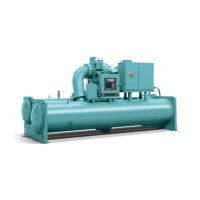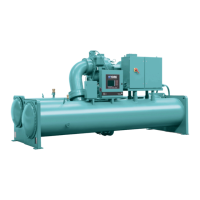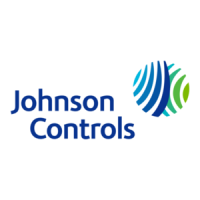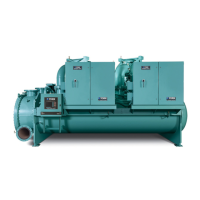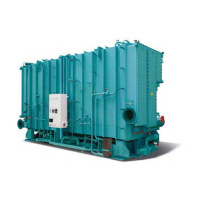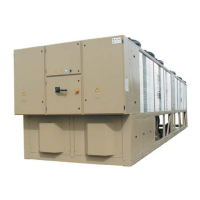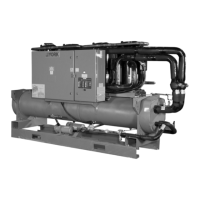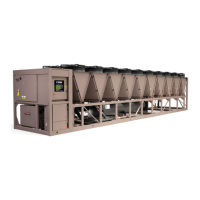FORM 160.54-O1
ISSUE DATE: 9/10/2014
JOHNSON CONTROLS
188
SECTION 3 - DISPLAY MESSAGES
VSD – Low DC Bus Voltage
(575V/60Hz applications)
(Software version C.OPT.01.15.xxx (or later))
If the DC Link Voltage falls below 600VDC while run-
ning, this shutdown is performed.
VSD – DC Bus Voltage Imbalance
The DC link is filtered by many large electrolytic ca-
pacitors, rated for 450VDC. These capacitors are wired
in series to achieve 900VDC capability for the DC
link. It is important that the voltage be shared equally
from the junction of the center, or series capacitor con-
nection, to the negative bus and the positive bus. This
center point should be approximately ½ of the total DC
Link Voltage. Most actual Bus Voltage Imbalance con-
ditions are caused by a shorted capacitor or a leaky or
shorted IGBT transistor in an output phase bank assem-
bly. This usually indicates the VSD requires service.
VSD – DC Bus Voltage Imbalance
(575V/60Hz applications)
(Software version C.OPT.01.15.xxx (or later))
If the Half DC Link Voltage does not remain within
plus or minus 106VDC of the DC Link Voltage divided
by 2 while running, this shutdown is performed.
VSD – Precharge – DC Bus Voltage Imbalance
This message indicates the same as the VSD-DC Bus
Voltage Imbalance message above, except the condi-
tion occurred during the prelube period.
VSD – Precharge-DC Bus Voltage
Imbalance
(575V/60Hz applications)
(Software version C.OPT.01.15.xxx (or later))
If the Half DC Link Voltage does not remain within
plus or minus 106VDC of the DC Link Voltage divided
by 2 during the pre-charge interval, this shutdown is
performed.
VSD – High Internal Ambient Temperature
The ambient temperature monitored is actually the
temperature detected by a component mounted on the
VSD Logic Board. The high ambient trip threshold is
set for 140°F. Some potential causes for this shutdown
are: internal VSD fan failure, VSD water pump failure
or an entering condenser water temperature that ex-
ceeds the allowable limit for the job. Additional causes
for the shutdown are:
• Plugged Strainer – The standard 1.5" Y-strainer
contains a woven mesh element with 20 stainless
steel wires per inch. This has been found to work
adequately on most applications. Some users may
have very dirty condenser water, which can cause
the strainer to plug. Locations with special condi-
tions may want to consider a dual strainer arrange-
ment with quarter turn valves, to permit cleaning
of one strainer with the unit still on line.
• Plugged Heat-exchanger – In cases where the
strainer plugs frequently, the heat-exchanger may
eventually plug or become restricted to the point
of reduced ow. At this point, we suggest you
back-ush the heat-exchanger by reversing the
two rubber hoses which supply condenser water
to-from the heat-exchanger. If the rust cannot be
back-ushed,theheat-exchangermighthavetobe
replaced.
• Low Condenser Flow – The VSD system requires
8 feet of pressure drop across the heat exchanger
to maintain adequate GPM. If the pressure drop is
less than 8 feet, it will be necessary to correct the
owproblemoraddaboosterpumpasisapplied
onretrotchillers.
VSD – Invalid Current Scale Selection
Since the part number of the VSD Logic Board is the
same on all horsepower sizes, the position of Program
Jumpers tells the Logic Board the size of the VSD
employed. This allows the VSD to properly scale the
output current. If the jumper configuration is invalid, a
shutdown is performed and this message is generated.
Refer to Variable Speed Drive – Service Instructions
(Form 160.00-M1).
VSD – Low Phase A Inverter Heatsink
Temperature
(Style D VSD)
A heatsink temperature sensor indicating a temperature
less than 37°F will cause the chiller to shut down and
display this message. In most cases, the problem will
be an open transmitter or broken wiring to the transmit-
ter. The normal transmitter resistance is 10K ohms at
77°F.
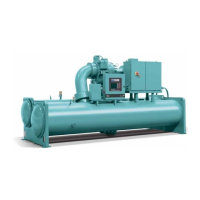
